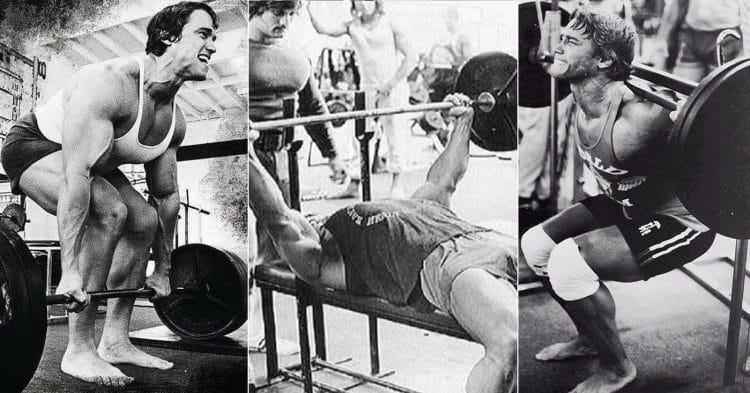To get the best from your training, you need to follow a well-designed strength training program. Yes, you COULD just turn up at the gym and make up your workout as you go along, what bodybuilding guru Joe Weider called the instinctive training and muscle confusion methods, but that’s not a recipe for long-term success.
Instead, following a program means you can logically and systematically manipulate the training variables (overload, volume, recovery, etc.) to ensure that you make progress. After all, how can you gradually make your training harder, the principle of progression, if you change your workout from one week to the next?
There are lots of different programs to follow. Some involve training your whole body 2-3 times per week, while others break your body down into individual muscles and muscle groups. We call these divided workout plans split routines.
Split routines can involve training as little as twice a week to training six times or more. The 5-day split is one of the most widely used approaches and is popular with recreational and competitive bodybuilders.
However, while this workout structure has some real benefits, there are a few drawbacks too. In this article, we discuss the pros and cons of the 5-day workout split and provide you with some tried and tested variations to try.
What Is a 5-Day Workout Split?
A five-day split is a type of bodybuilding workout where you train five days per week. In most cases, this involves dividing your body down into five muscle groups and working each one once per week. However, this is not always the case, and some five-day variations allow you to hit muscle groups twice per seven-day rotation.
There is no “official” five-day split routine; it’s merely a framework into which you can slot the exercises you want to do. Also, because it’s a flexible approach to training, you can modify this workout to suit your current fitness goals and training needs.
5-Day Workout Split – Pros
The 5-day workout is popular because it works. For a lot of lifters, it provides the ideal way to build muscle and strength. The main pros of training five days a week are:
Plenty of training volume per muscle group– with most 5-day split programs, you train just one or two muscle groups per workout. This gives you more than enough time to do plenty of sets. Training volume is important for hypertrophy (muscle growth). Training more muscle groups per workout usually means a lower volume.
 Split Exercises
Split Exercises
You can work your muscles from lots of different angles– with an entire session dedicated to one or two muscle groups, you’ll be able to use a variety of exercises to hit your muscles from all available angles.
For example, instead of just doing squats for your legs or bench press for your chest, you’ll be able to include many more exercises which may increase hypertrophy and sculpt a more aesthetically pleasing physique.
Increased caloric expenditure– training five times a week means you’ll be expending plenty of energy. This could help you get leaner or lose weight or maintain your current bodyweight without the need for additional cardio.
Ideal for weekday exercisers– a lot of people like to keep their weekends free. The five-day workout split is ideal for this purpose. Just train Monday to Friday, and rest Saturday and Sunday. After two days off, you’ll be ready to get back in the gym and start again on Monday.
A good balance between training and recovery– the 5-day workout split provides a good balance between work and rest. By rotating muscle groups, you avoid overloading any one body part, and two days off per week will provide a welcome break from training. For most lifters, this is a better approach than training six or more days per week, which can soon lead to overtraining.
5-Day Workout Split – Cons
While the 5-day workout is popular and can be very effective, it is not without drawbacks. Consider the following before you try the 5-day training split for yourself:


A big commitment– training five days a week is a big commitment. Just one missed workout will unbalance your entire training week and could lead to underdeveloped muscle groups. If you are short on training time or have a tendency to skip workouts, this is not the training split for you.
You’ll need to pay attention to rest and recovery– following a five-way split will take a lot out of your body. After all, there are only two rest days per week. Because of this, you’ll need to pay extra attention to nutrition, rest, and recovery if you work out five days in seven.
Could lead to overtraining– while an hour or so is a suitable time for training large muscle groups, it may be too long for smaller body parts. For example, just because you’ve got an hour to train your arms doesn’t mean you should. Modify your training volume according to the muscle you are training to avoid overdoing it. An hour of biceps or calf training could be counterproductive.
Not really suitable for beginners– if you are new to strength training, a five-day workout split could be too advanced for you. All that volume and variety will probably leave you feeling tired and sore. A three or four-day split is perhaps a better choice for most beginners. That way, when you are ready, you can step up to training five days a week to maintain your progress.
Requires careful planning– if you write your own 5-day workout split, you need to be careful not to place similar muscle groups on consecutive days. For example, if you trained your chest on Monday, your shoulders on Tuesday, and your triceps on Wednesday, you will end up doing three “pushing” workouts in a row. Avoid overlapping closely related muscle groups to prevent overtraining, provide adequate recovery, and ensure that you have plenty of energy for your workouts.
Not a lot of time for cardio– if you like to do weights and cardio, you may find the five-way split too restrictive. While you COULD do cardio after strength training, you will probably find that you run out of energy. Doing cardio on your rest days could also interfere with recovery. If cardio training is important to you, a three or four-way split may be more productive.
Sample 5-Day Workout Splits
There are lots of different interpretations of the five-day workout split. Design your own or follow one of our tried-and-tested examples.
Before you start any of these workouts, make sure you spend a few minutes warming up and preparing your body for what you are about to do. Start with a few minutes of easy cardio to raise your core temperature and increase blood flow.
After that, do a few dynamic flexibility and joint mobility exercises for the body parts you are about to train. Finally, do a few easy sets of the main exercises in your workout to ensure you are as warm and ready to work as possible.
Regarding rest days, if you prefer to train on weekdays and take the weekends off, you are free to do so. However, a mid-week rest can also be beneficial. Try both options and see which one you prefer.
Adjust the following workouts to match your training goal:
5-Day Workout Split #1 – The body part split


This is the simplest way to do a five-way workout split. Just divide your body down into five muscle groups and train each one per workout. Note the order of the workouts; similar muscle groups are kept far apart to allow for optimal recovery.
Chest
[*]Bench press
[*]Incline dumbbell press
[*]Decline cable crossover
[*]Push-up
[*]Dumbbell pullover
Back
[*]Deadlift
[*]Pull-up
[*]Single-arm bent-over row
[*]Lat pulldown
[*]Chest supported row
Shoulders
[*]Standing barbell press
[*]Seated dumbbell alternating overhead press
[*]Lateral raise
[*]Reverse fly
Legs
[*]Barbell back squat
[*]Romanian deadlift
[*]Leg press
[*]Leg curl
[*]Leg extension
[*]Standing calf raise
Arms and abs
[*]Barbell curl
[*]Barbell skull crusher
[*]Alternating dumbbell curl
[*]Rope pushdown
[*]Hanging knee raise
[*]Cable crunches
[*]Cable wood chop
5-Day Workout Split #2 – Variation


With this variation, you train two muscle groups per workout, and your arms get two workouts per week. This is a good option if your arm development needs a boost or you prefer more variety in your workouts.
On the downside, this program will probably mean spending more time in the gym.
Monday
Chest and triceps
Tuesday
Back and biceps
Wednesday
Quads and calves
Thursday
Rest
Friday
Shoulders and arms
Saturday
Hamstrings and abs
Sunday
Rest
Chest and triceps
[*]Dumbbell bench press
[*]Incline dumbbell fly
[*]Pec deck
[*]Dumbbell overhead triceps extension
[*]Single-arm cable kickback
Back and biceps
[*]Rack pull
[*]Kroc row
[*]Lat pulldown
[*]EZ biceps curl
[*]Zottman curl
Quads and calves
[*]Front squat
[*]Walking lunge
[*]Step-up
[*]Leg extension
[*]Seated calf raise
[*]Standing calf raise
Shoulders and arms
[*]Arnold press
[*]Upright row
[*]Cable lateral raise
[*]Preacher curl
[*]Dip
[*]Concentration curl
[*]Reverse grip pushdown
Hamstrings and abs
[*]Stiff-leg deadlift
[*]Leg curl
[*]Single-leg Romanian deadlift
[*]Hip thrust
[*]Weighted plank
[*]Side plank/leg lift
[*]Reverse crunch
5-Day Workout Split #3 – Upper/Lower/Push/Pull/Legs


Most 5-day workout splits train each muscle group once per week. Some lifters prefer more volume than this. The Upper / Lower / Push/Pull / Legs trains each muscle group twice per week by combing two different split routines. For added variety, you could use different set and rep schemes on different training days.
For example, sets of 5-8 reps for the first two workouts and 9-12 for the last three.
Monday
Upper body
Tuesday
Lower body
Wednesday
Rest
Thursday
Push (chest, shoulders, triceps)
Friday
Pull (back, biceps, abs)
Saturday
Legs
Sunday
Rest
Upper body
[*]Bench press
[*]Barbell bent-over row
[*]Barbell push-press
[*]Pull-up
[*]Barbell curl
[*]Dumbbell skull crusher
Lower body
[*]Barbell back squat
[*]Romanian deadlift
[*]Hack squat
[*]Leg curl
[*]Standing calf raise
Push (chest, shoulders, triceps)
[*]Dumbbell bench press
[*]Incline barbell bench press
[*]Pec deck
[*]Seated dumbbell shoulder press
[*]Lateral raise
[*]Triceps pushdown
[*]Barbell kickback
Pull (back, biceps, abs)
[*]Weighted pull-up
[*]Seated cable row
[*]Pullover machine
[*]Barbell drag curl
[*]Barbell reverse curl
[*]V-sit
[*]Russian twist
Legs
[*]Box squat
[*]Snatch-grip deadlift
[*]Leg extension
[*]Nordic leg curl
[*]Box jumps
[*]Seated calf raise
5-Day Workout Split – Wrapping Up
While there is no single best 5-day workout split, there are lots of ways to use this popular training schedule. It’s ideal for intermediate and advanced bodybuilders who want plenty of time to train each muscle group from a variety of angles and with a decent amount of volume. You can also modify this approach so that you train each muscle group twice a week.
On the downside, training five times a week is a significant commitment in terms of time AND energy. If you’re busy or struggle to recover between workouts, this may not be the split for you, and you may do better on a three or four-way split.
But, if you can stick with it, the 5-day workout split should provide you with the results you want. Create your own or follow one of our proven variations.
Click here to view the article.
Instead, following a program means you can logically and systematically manipulate the training variables (overload, volume, recovery, etc.) to ensure that you make progress. After all, how can you gradually make your training harder, the principle of progression, if you change your workout from one week to the next?
There are lots of different programs to follow. Some involve training your whole body 2-3 times per week, while others break your body down into individual muscles and muscle groups. We call these divided workout plans split routines.
Split routines can involve training as little as twice a week to training six times or more. The 5-day split is one of the most widely used approaches and is popular with recreational and competitive bodybuilders.
However, while this workout structure has some real benefits, there are a few drawbacks too. In this article, we discuss the pros and cons of the 5-day workout split and provide you with some tried and tested variations to try.
What Is a 5-Day Workout Split?
A five-day split is a type of bodybuilding workout where you train five days per week. In most cases, this involves dividing your body down into five muscle groups and working each one once per week. However, this is not always the case, and some five-day variations allow you to hit muscle groups twice per seven-day rotation.
There is no “official” five-day split routine; it’s merely a framework into which you can slot the exercises you want to do. Also, because it’s a flexible approach to training, you can modify this workout to suit your current fitness goals and training needs.
5-Day Workout Split – Pros
The 5-day workout is popular because it works. For a lot of lifters, it provides the ideal way to build muscle and strength. The main pros of training five days a week are:
Plenty of training volume per muscle group– with most 5-day split programs, you train just one or two muscle groups per workout. This gives you more than enough time to do plenty of sets. Training volume is important for hypertrophy (muscle growth). Training more muscle groups per workout usually means a lower volume.

You can work your muscles from lots of different angles– with an entire session dedicated to one or two muscle groups, you’ll be able to use a variety of exercises to hit your muscles from all available angles.
For example, instead of just doing squats for your legs or bench press for your chest, you’ll be able to include many more exercises which may increase hypertrophy and sculpt a more aesthetically pleasing physique.
Increased caloric expenditure– training five times a week means you’ll be expending plenty of energy. This could help you get leaner or lose weight or maintain your current bodyweight without the need for additional cardio.
Ideal for weekday exercisers– a lot of people like to keep their weekends free. The five-day workout split is ideal for this purpose. Just train Monday to Friday, and rest Saturday and Sunday. After two days off, you’ll be ready to get back in the gym and start again on Monday.
A good balance between training and recovery– the 5-day workout split provides a good balance between work and rest. By rotating muscle groups, you avoid overloading any one body part, and two days off per week will provide a welcome break from training. For most lifters, this is a better approach than training six or more days per week, which can soon lead to overtraining.
5-Day Workout Split – Cons
While the 5-day workout is popular and can be very effective, it is not without drawbacks. Consider the following before you try the 5-day training split for yourself:


A big commitment– training five days a week is a big commitment. Just one missed workout will unbalance your entire training week and could lead to underdeveloped muscle groups. If you are short on training time or have a tendency to skip workouts, this is not the training split for you.
You’ll need to pay attention to rest and recovery– following a five-way split will take a lot out of your body. After all, there are only two rest days per week. Because of this, you’ll need to pay extra attention to nutrition, rest, and recovery if you work out five days in seven.
Could lead to overtraining– while an hour or so is a suitable time for training large muscle groups, it may be too long for smaller body parts. For example, just because you’ve got an hour to train your arms doesn’t mean you should. Modify your training volume according to the muscle you are training to avoid overdoing it. An hour of biceps or calf training could be counterproductive.
Not really suitable for beginners– if you are new to strength training, a five-day workout split could be too advanced for you. All that volume and variety will probably leave you feeling tired and sore. A three or four-day split is perhaps a better choice for most beginners. That way, when you are ready, you can step up to training five days a week to maintain your progress.
Requires careful planning– if you write your own 5-day workout split, you need to be careful not to place similar muscle groups on consecutive days. For example, if you trained your chest on Monday, your shoulders on Tuesday, and your triceps on Wednesday, you will end up doing three “pushing” workouts in a row. Avoid overlapping closely related muscle groups to prevent overtraining, provide adequate recovery, and ensure that you have plenty of energy for your workouts.
Not a lot of time for cardio– if you like to do weights and cardio, you may find the five-way split too restrictive. While you COULD do cardio after strength training, you will probably find that you run out of energy. Doing cardio on your rest days could also interfere with recovery. If cardio training is important to you, a three or four-way split may be more productive.
Sample 5-Day Workout Splits
There are lots of different interpretations of the five-day workout split. Design your own or follow one of our tried-and-tested examples.
Before you start any of these workouts, make sure you spend a few minutes warming up and preparing your body for what you are about to do. Start with a few minutes of easy cardio to raise your core temperature and increase blood flow.
After that, do a few dynamic flexibility and joint mobility exercises for the body parts you are about to train. Finally, do a few easy sets of the main exercises in your workout to ensure you are as warm and ready to work as possible.
Regarding rest days, if you prefer to train on weekdays and take the weekends off, you are free to do so. However, a mid-week rest can also be beneficial. Try both options and see which one you prefer.
Adjust the following workouts to match your training goal:
5-Day Workout Split #1 – The body part split


This is the simplest way to do a five-way workout split. Just divide your body down into five muscle groups and train each one per workout. Note the order of the workouts; similar muscle groups are kept far apart to allow for optimal recovery.
Chest
[*]Bench press
[*]Incline dumbbell press
[*]Decline cable crossover
[*]Push-up
[*]Dumbbell pullover
Back
[*]Deadlift
[*]Pull-up
[*]Single-arm bent-over row
[*]Lat pulldown
[*]Chest supported row
Shoulders
[*]Standing barbell press
[*]Seated dumbbell alternating overhead press
[*]Lateral raise
[*]Reverse fly
Legs
[*]Barbell back squat
[*]Romanian deadlift
[*]Leg press
[*]Leg curl
[*]Leg extension
[*]Standing calf raise
Arms and abs
[*]Barbell curl
[*]Barbell skull crusher
[*]Alternating dumbbell curl
[*]Rope pushdown
[*]Hanging knee raise
[*]Cable crunches
[*]Cable wood chop
5-Day Workout Split #2 – Variation


With this variation, you train two muscle groups per workout, and your arms get two workouts per week. This is a good option if your arm development needs a boost or you prefer more variety in your workouts.
On the downside, this program will probably mean spending more time in the gym.
Monday
Chest and triceps
Tuesday
Back and biceps
Wednesday
Quads and calves
Thursday
Rest
Friday
Shoulders and arms
Saturday
Hamstrings and abs
Sunday
Rest
Chest and triceps
[*]Dumbbell bench press
[*]Incline dumbbell fly
[*]Pec deck
[*]Dumbbell overhead triceps extension
[*]Single-arm cable kickback
Back and biceps
[*]Rack pull
[*]Kroc row
[*]Lat pulldown
[*]EZ biceps curl
[*]Zottman curl
Quads and calves
[*]Front squat
[*]Walking lunge
[*]Step-up
[*]Leg extension
[*]Seated calf raise
[*]Standing calf raise
Shoulders and arms
[*]Arnold press
[*]Upright row
[*]Cable lateral raise
[*]Preacher curl
[*]Dip
[*]Concentration curl
[*]Reverse grip pushdown
Hamstrings and abs
[*]Stiff-leg deadlift
[*]Leg curl
[*]Single-leg Romanian deadlift
[*]Hip thrust
[*]Weighted plank
[*]Side plank/leg lift
[*]Reverse crunch
5-Day Workout Split #3 – Upper/Lower/Push/Pull/Legs


Most 5-day workout splits train each muscle group once per week. Some lifters prefer more volume than this. The Upper / Lower / Push/Pull / Legs trains each muscle group twice per week by combing two different split routines. For added variety, you could use different set and rep schemes on different training days.
For example, sets of 5-8 reps for the first two workouts and 9-12 for the last three.
Monday
Upper body
Tuesday
Lower body
Wednesday
Rest
Thursday
Push (chest, shoulders, triceps)
Friday
Pull (back, biceps, abs)
Saturday
Legs
Sunday
Rest
Upper body
[*]Bench press
[*]Barbell bent-over row
[*]Barbell push-press
[*]Pull-up
[*]Barbell curl
[*]Dumbbell skull crusher
Lower body
[*]Barbell back squat
[*]Romanian deadlift
[*]Hack squat
[*]Leg curl
[*]Standing calf raise
Push (chest, shoulders, triceps)
[*]Dumbbell bench press
[*]Incline barbell bench press
[*]Pec deck
[*]Seated dumbbell shoulder press
[*]Lateral raise
[*]Triceps pushdown
[*]Barbell kickback
Pull (back, biceps, abs)
[*]Weighted pull-up
[*]Seated cable row
[*]Pullover machine
[*]Barbell drag curl
[*]Barbell reverse curl
[*]V-sit
[*]Russian twist
Legs
[*]Box squat
[*]Snatch-grip deadlift
[*]Leg extension
[*]Nordic leg curl
[*]Box jumps
[*]Seated calf raise
5-Day Workout Split – Wrapping Up
While there is no single best 5-day workout split, there are lots of ways to use this popular training schedule. It’s ideal for intermediate and advanced bodybuilders who want plenty of time to train each muscle group from a variety of angles and with a decent amount of volume. You can also modify this approach so that you train each muscle group twice a week.
On the downside, training five times a week is a significant commitment in terms of time AND energy. If you’re busy or struggle to recover between workouts, this may not be the split for you, and you may do better on a three or four-way split.
But, if you can stick with it, the 5-day workout split should provide you with the results you want. Create your own or follow one of our proven variations.
Click here to view the article.

